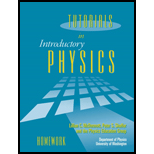
Tutorials In Introductory Physics: Homework
1st Edition
ISBN: 9780130662453
Author: Lillian C. McDermott, Peter S. Shaffer
Publisher: PEARSON
expand_more
expand_more
format_list_bulleted
Concept explainers
Question
Chapter 13.2, Problem 1bT
(1)
To determine
The free body diagram of block.
(2)
To determine
The net force on the block.
(3)
To determine
The nature of work done for different cases.
(4)
To determine
The nature of work done by the block on the hand.
(5)
To determine
The consistency of answer in part 3 with work-kinetic energy theorem.
(6)
To determine
The changes if block is being pushed up the incline at constant speed.
Expert Solution & Answer
Want to see the full answer?
Check out a sample textbook solution
Students have asked these similar questions
A pendulum has a 0.4-m-long cord and is given a tangential velocity of 0.2 m/s toward the
vertical from a position 0 = 0.3 rad.
Part A
Determine the equation which describes the angular motion.
Express your answer in terms of the variable t. Express coefficients in radians to three significant figures.
ΜΕ ΑΣΦ
vec
(t)=0.3 cos (4.95t) + 0.101 sin (4.95t)
Submit Previous Answers Request Answer
× Incorrect; Try Again; 6 attempts remaining
Part A
■Review
The uniform 150-lb stone (rectangular block) is being turned over on its side by pulling the
vertical cable slowly upward until the stone begins to tip.
(Figure 1)
If it then falls freely (T = 0) from an essentially balanced at-rest position, determine the speed at which the corner A strikes the pad at B. The stone does not slip at its corner C as it falls. Suppose that height of the stone is
L = 1.2 ft.
Express your answer to three significant figures and include the appropriate units.
?
ft
VA 10.76
S
Submit Previous Answers Request Answer
× Incorrect; Try Again; 6 attempts remaining
Consider the circuit shown in the figure. The battery has emf ε = 69 volts and negligible internal resistance. The inductance is L = 0.4 H and the resistances are R 1 = 12 Ω and R 2 = 9.0 Ω. Initially the switch S is open and no currents flow. Then the switch is closed. After leaving the switch closed for a very long time, it is opened again. Just after it is opened, what is the current in R 1?
Chapter 13 Solutions
Tutorials In Introductory Physics: Homework
Ch. 13.1 - Prob. 1aTCh. 13.1 - In the space provided, draw an arrow to indicate...Ch. 13.1 - Prob. 1cTCh. 13.1 - Prob. 1dTCh. 13.1 - Prob. 1eTCh. 13.1 - Prob. 2aTCh. 13.1 - Prob. 2bTCh. 13.1 - Consider the following student dialogue. Student...Ch. 13.1 - Sketch the process described in section II on the...Ch. 13.1 - Prob. 3bT
Ch. 13.1 - Prob. 4aTCh. 13.1 - A student looks up the molar masses and finds the...Ch. 13.1 - Prob. 4cTCh. 13.2 - Recall the definition of work done on an object by...Ch. 13.2 - Prob. 1bTCh. 13.2 - Prob. 1cTCh. 13.2 - Prob. 2aTCh. 13.2 - Does the internal energy of a gas in an insulated...Ch. 13.2 - Two students are discussing process 1: Student 1:...Ch. 13.2 - Imagine that the cylinder from section II is no...Ch. 13.2 - In process 2, is the heat transfer to the gas...Ch. 13.2 - Prob. 3cTCh. 13.2 - Prob. 4aTCh. 13.2 - In process 1 (section II) you did not need to...Ch. 13.2 - In process 2 (section III) you did not need to...Ch. 13.2 - Prob. 4dTCh. 13.2 - How does the compression in process 3 differ from...Ch. 13.2 - A student is considering process 3: “The...
Knowledge Booster
Learn more about
Need a deep-dive on the concept behind this application? Look no further. Learn more about this topic, physics and related others by exploring similar questions and additional content below.Similar questions
- A capacitor with a capacitance of C = 5.95×10−5 F is charged by connecting it to a 12.5 −V battery. The capacitor is then disconnected from the battery and connected across an inductor with an inductance of L = 1.55 H . At the time 2.35×10−2 s after the connection to the inductor is made, what is the current in the inductor? At that time, how much electrical energy is stored in the inductor?arrow_forwardCan someone help me with this question. Thanks.arrow_forwardCan someone help me with this question. Thanks.arrow_forward
arrow_back_ios
SEE MORE QUESTIONS
arrow_forward_ios
Recommended textbooks for you
 Glencoe Physics: Principles and Problems, Student...PhysicsISBN:9780078807213Author:Paul W. ZitzewitzPublisher:Glencoe/McGraw-Hill
Glencoe Physics: Principles and Problems, Student...PhysicsISBN:9780078807213Author:Paul W. ZitzewitzPublisher:Glencoe/McGraw-Hill Physics for Scientists and Engineers, Technology ...PhysicsISBN:9781305116399Author:Raymond A. Serway, John W. JewettPublisher:Cengage Learning
Physics for Scientists and Engineers, Technology ...PhysicsISBN:9781305116399Author:Raymond A. Serway, John W. JewettPublisher:Cengage Learning Principles of Physics: A Calculus-Based TextPhysicsISBN:9781133104261Author:Raymond A. Serway, John W. JewettPublisher:Cengage Learning
Principles of Physics: A Calculus-Based TextPhysicsISBN:9781133104261Author:Raymond A. Serway, John W. JewettPublisher:Cengage Learning Physics for Scientists and EngineersPhysicsISBN:9781337553278Author:Raymond A. Serway, John W. JewettPublisher:Cengage Learning
Physics for Scientists and EngineersPhysicsISBN:9781337553278Author:Raymond A. Serway, John W. JewettPublisher:Cengage Learning Physics for Scientists and Engineers with Modern ...PhysicsISBN:9781337553292Author:Raymond A. Serway, John W. JewettPublisher:Cengage Learning
Physics for Scientists and Engineers with Modern ...PhysicsISBN:9781337553292Author:Raymond A. Serway, John W. JewettPublisher:Cengage Learning College PhysicsPhysicsISBN:9781305952300Author:Raymond A. Serway, Chris VuillePublisher:Cengage Learning
College PhysicsPhysicsISBN:9781305952300Author:Raymond A. Serway, Chris VuillePublisher:Cengage Learning

Glencoe Physics: Principles and Problems, Student...
Physics
ISBN:9780078807213
Author:Paul W. Zitzewitz
Publisher:Glencoe/McGraw-Hill

Physics for Scientists and Engineers, Technology ...
Physics
ISBN:9781305116399
Author:Raymond A. Serway, John W. Jewett
Publisher:Cengage Learning

Principles of Physics: A Calculus-Based Text
Physics
ISBN:9781133104261
Author:Raymond A. Serway, John W. Jewett
Publisher:Cengage Learning

Physics for Scientists and Engineers
Physics
ISBN:9781337553278
Author:Raymond A. Serway, John W. Jewett
Publisher:Cengage Learning

Physics for Scientists and Engineers with Modern ...
Physics
ISBN:9781337553292
Author:Raymond A. Serway, John W. Jewett
Publisher:Cengage Learning

College Physics
Physics
ISBN:9781305952300
Author:Raymond A. Serway, Chris Vuille
Publisher:Cengage Learning